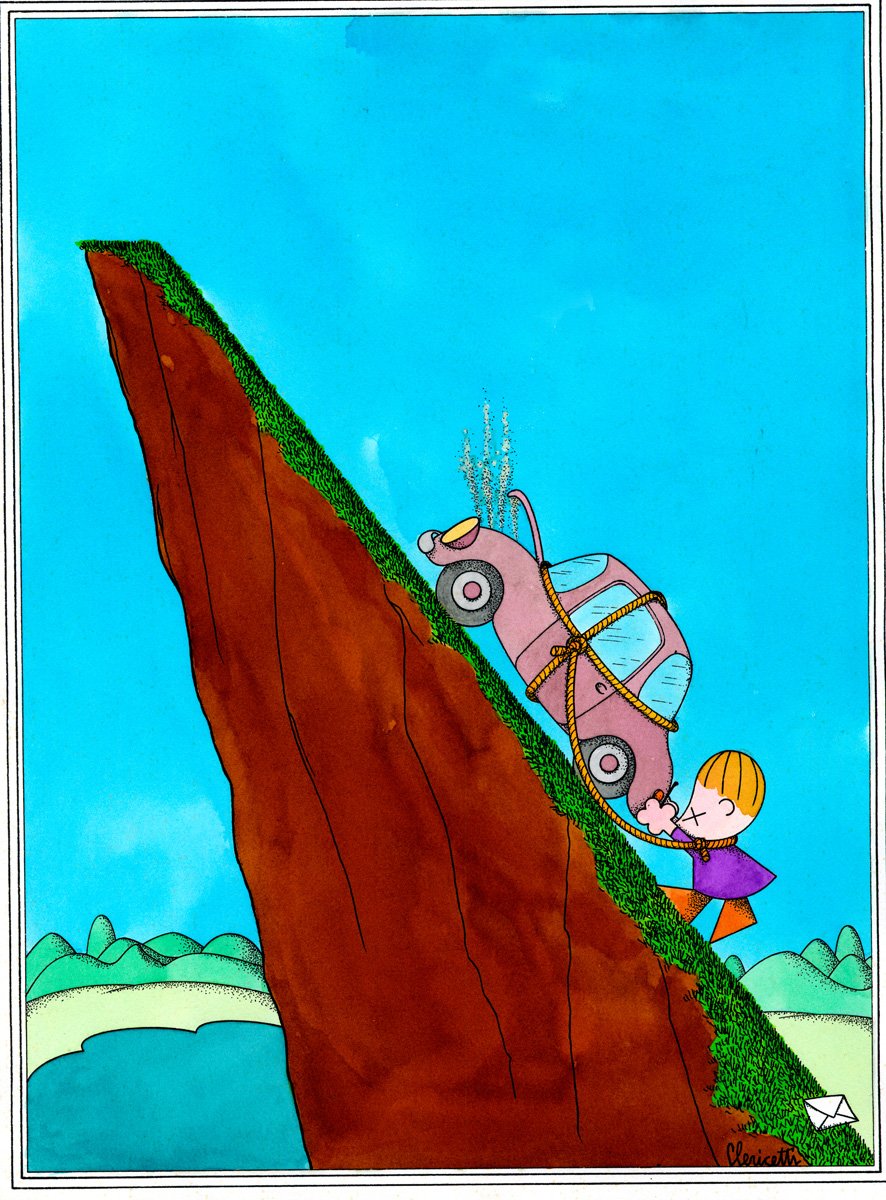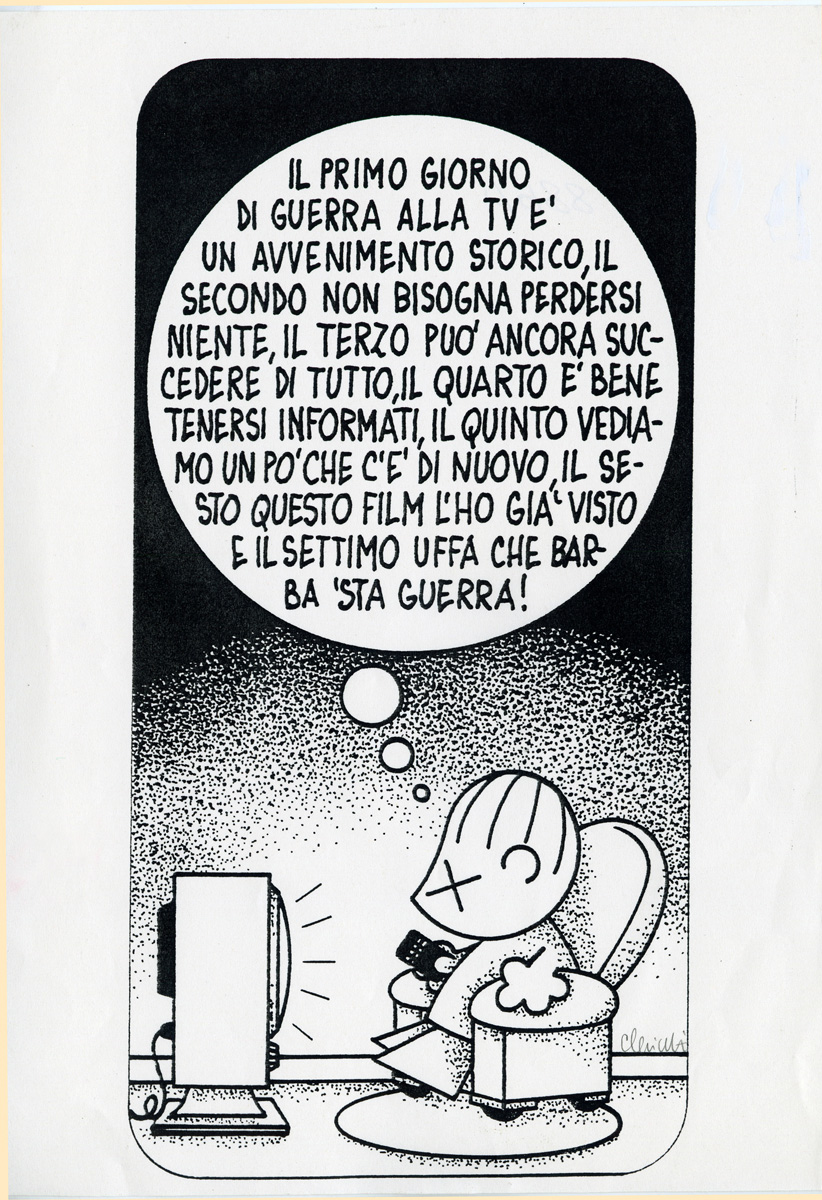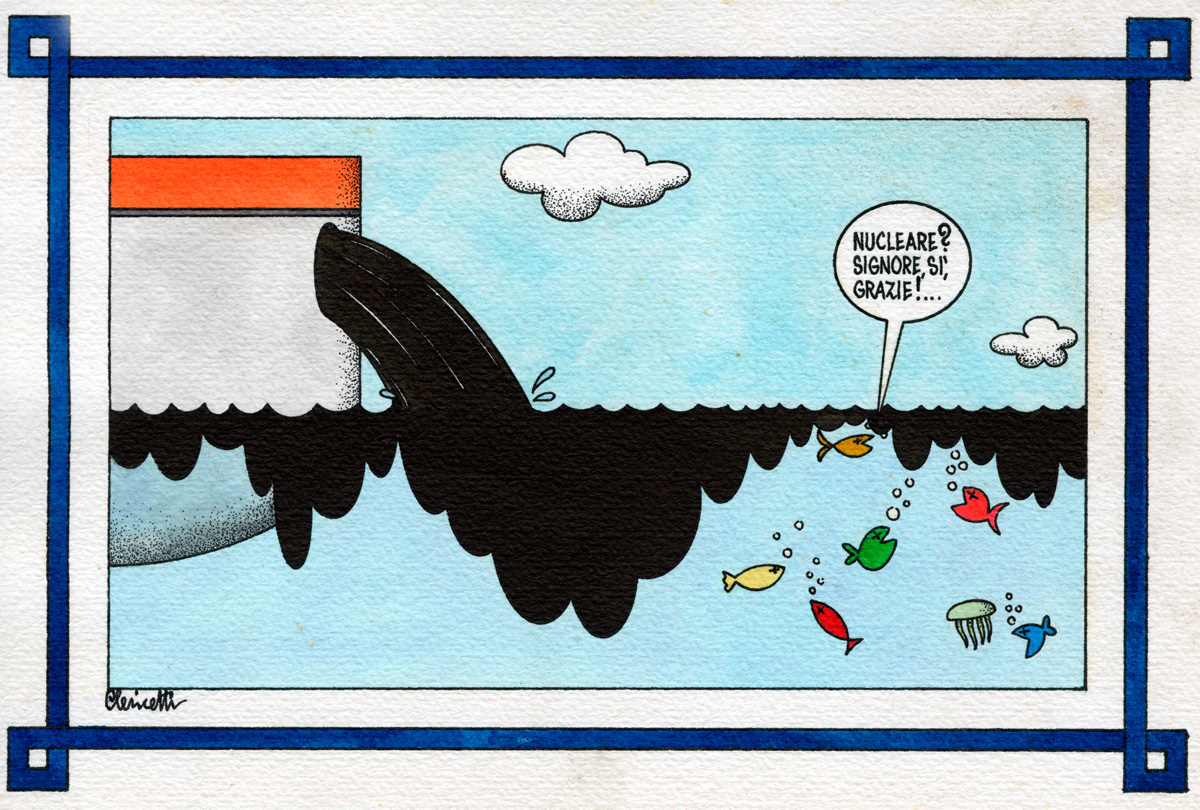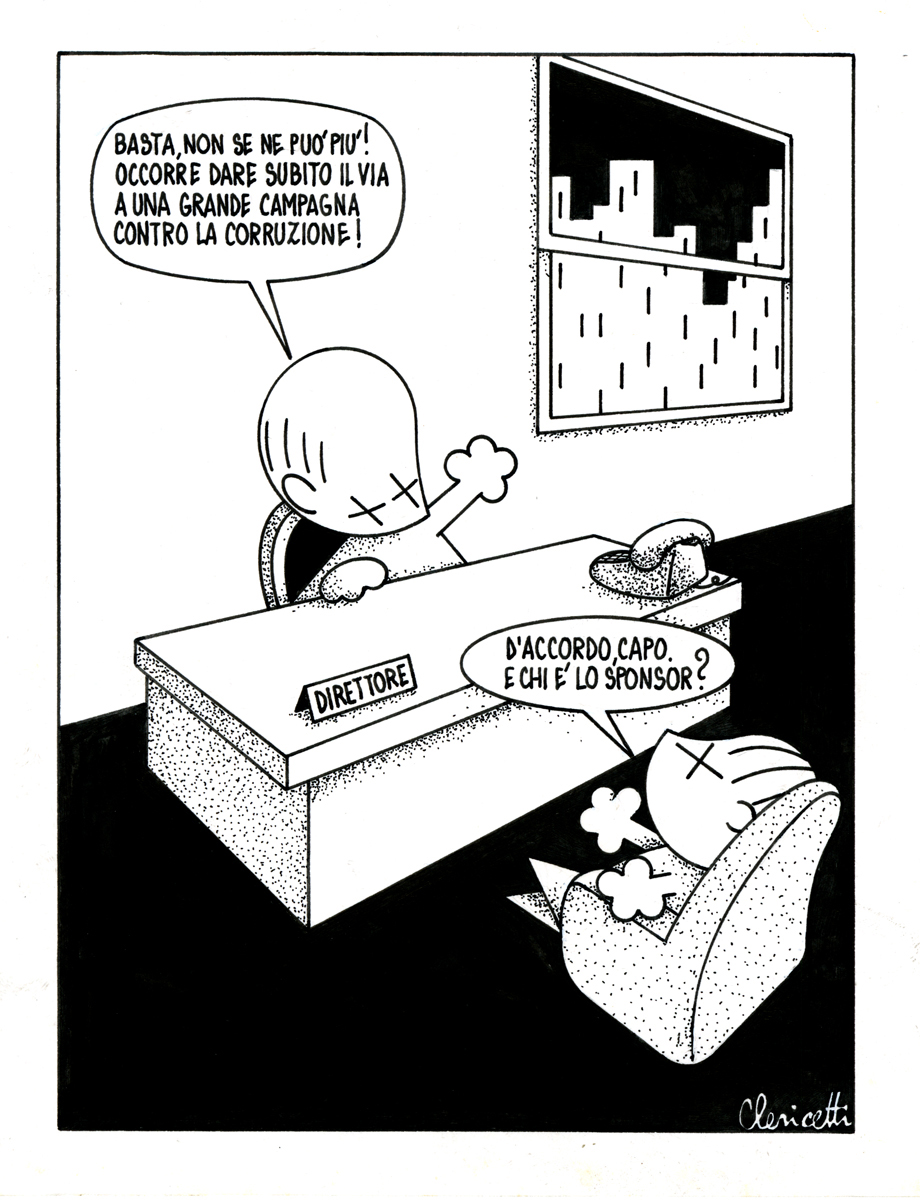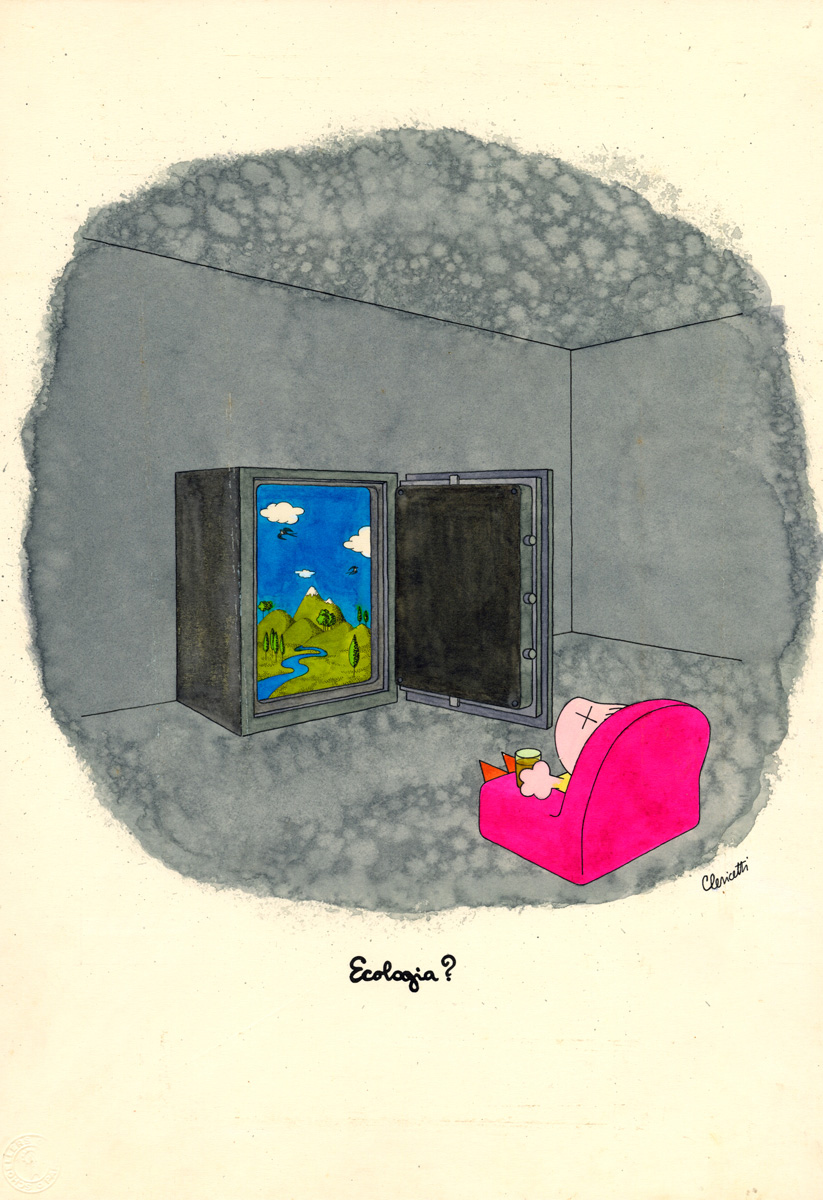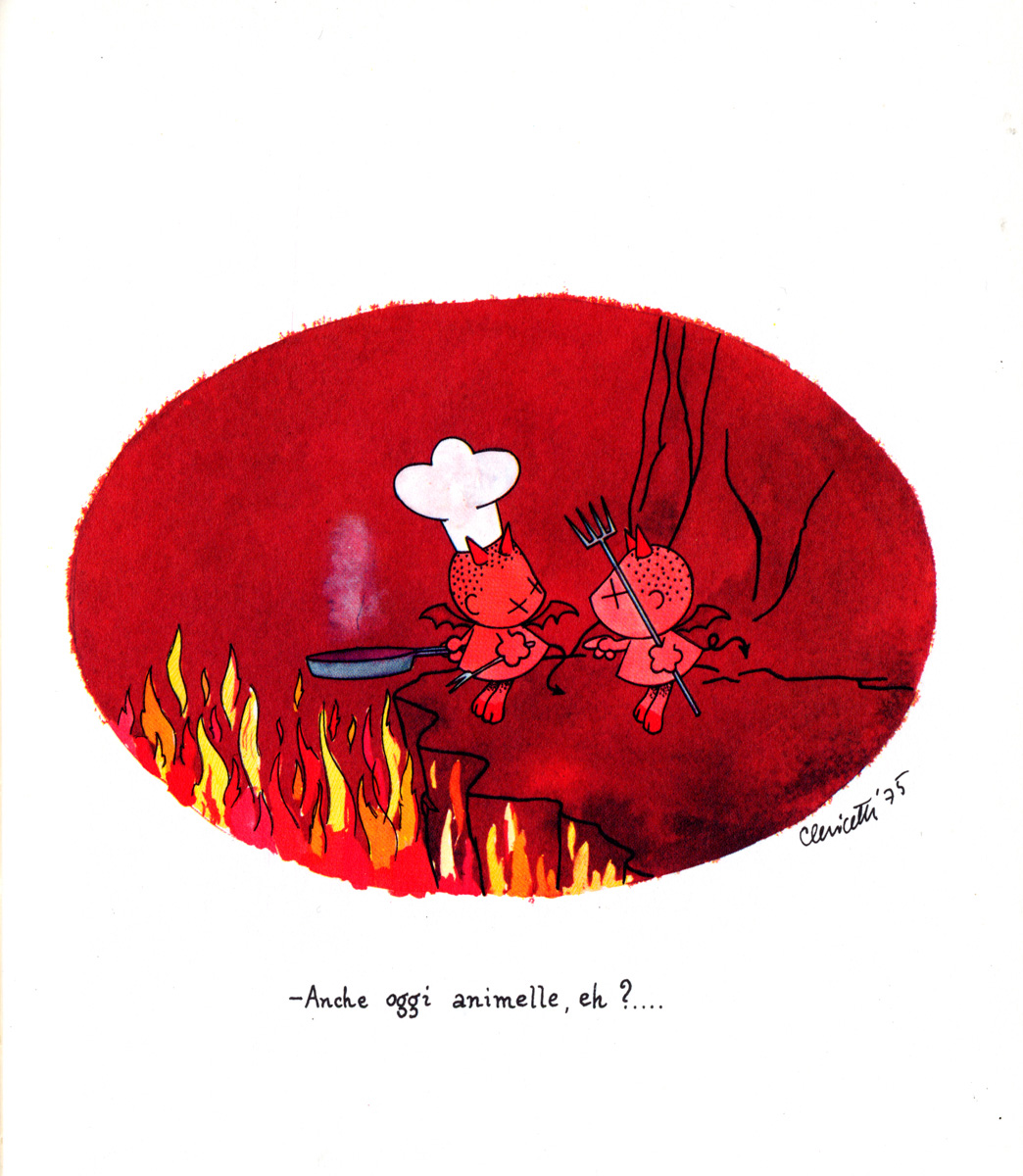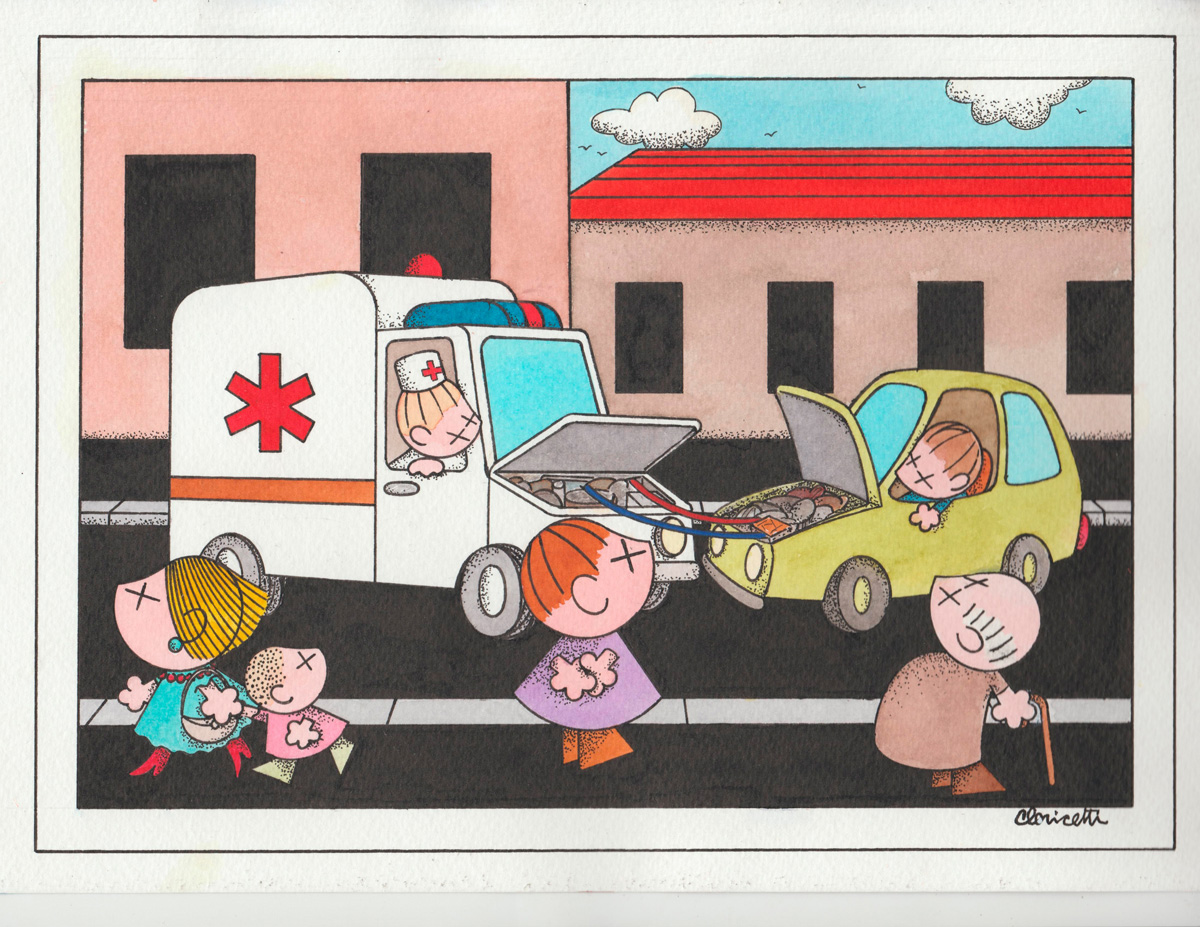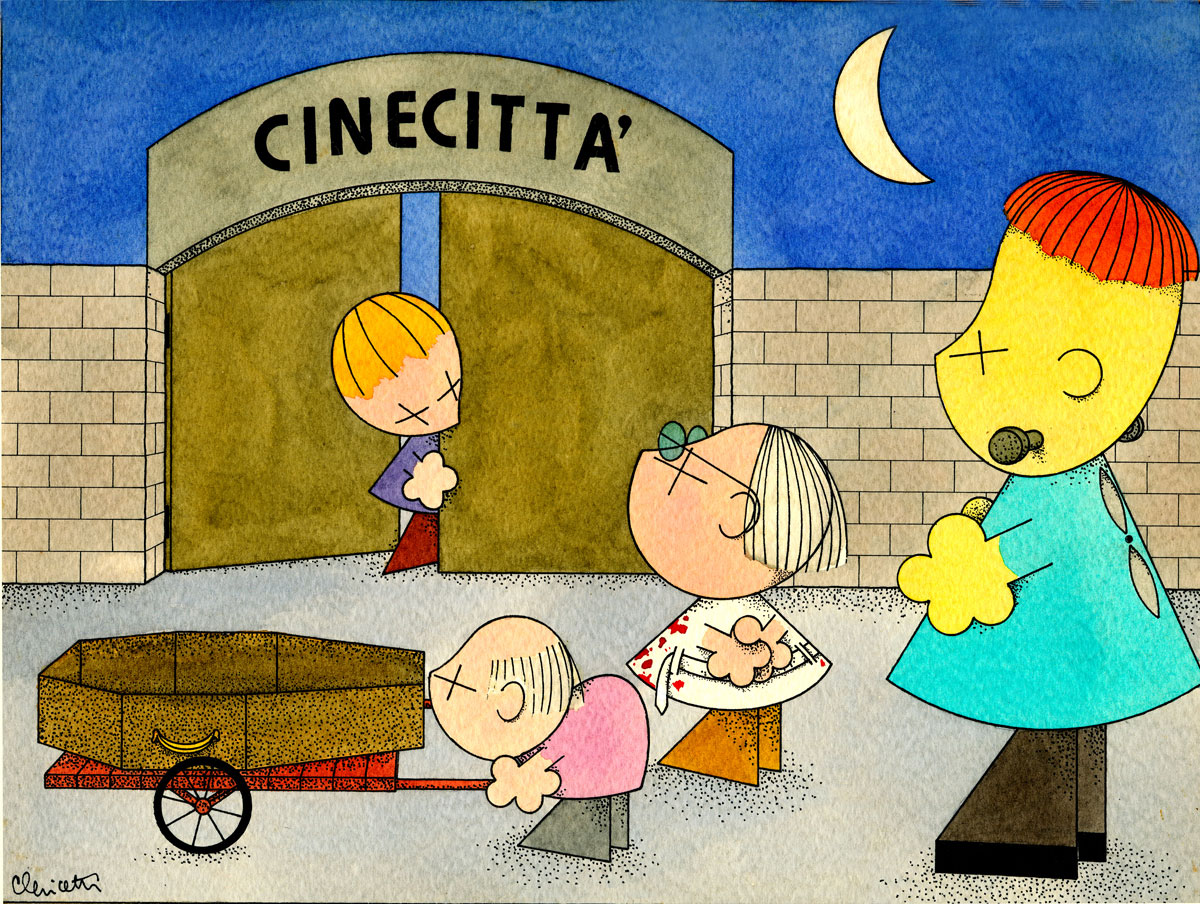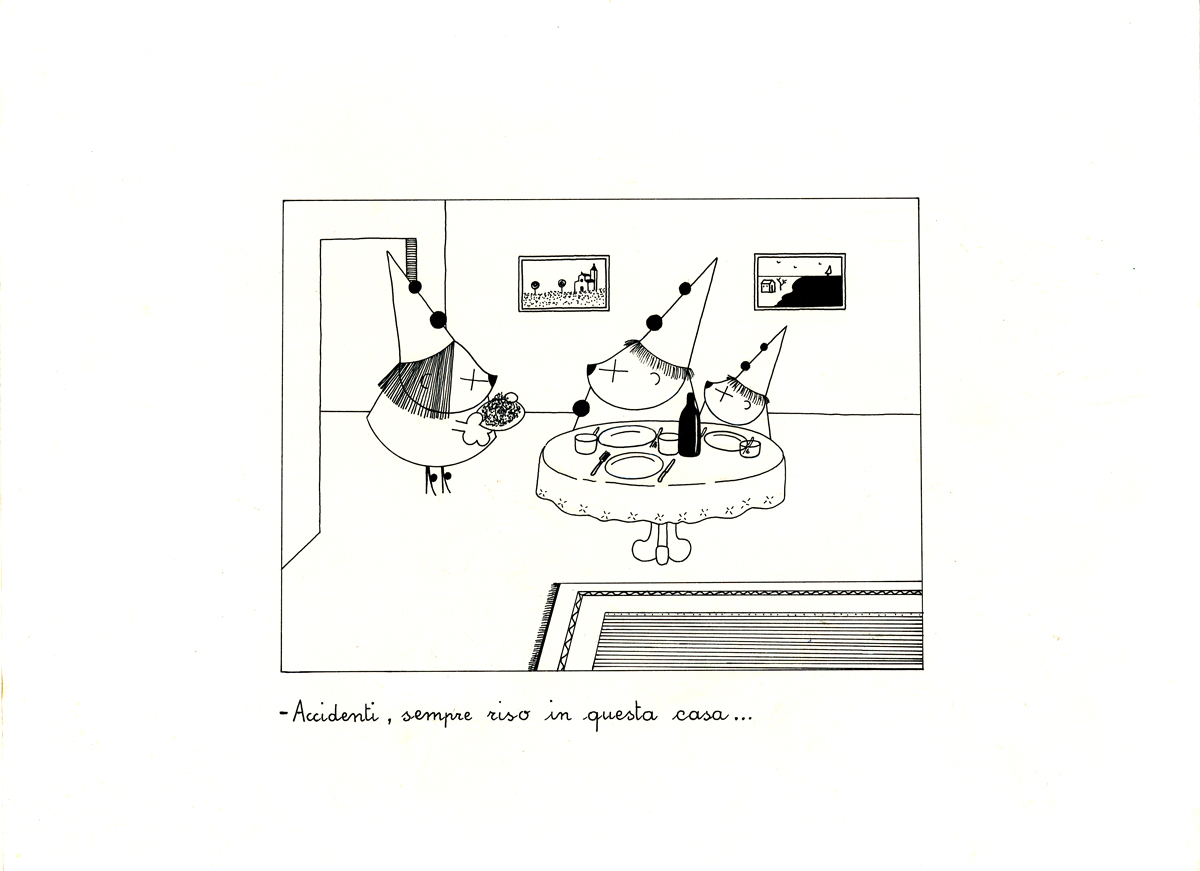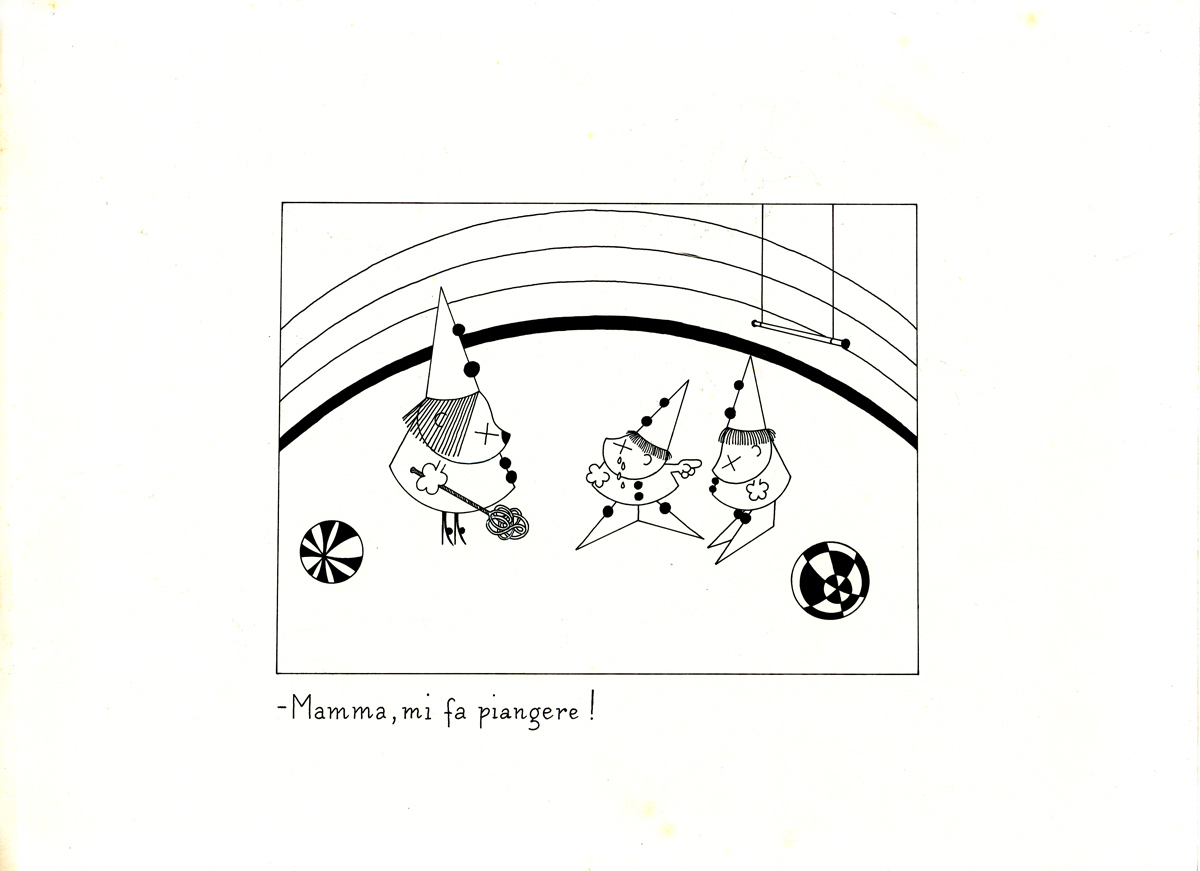Different latitudes and languages, personal lives and collective lives, humor as a litmus test of the world
- 1 - A memory of Salone and Bordighera
My first memory of the Salone Internazionale dell’Umorismo dates back to my first participation and in particular to my first trip to Bordighera. After the awards ceremony, I received the communication that I had won a cup and that to have it I had to collect it personally. I left by car from Milan, but when I arrived the festive days of the humorists, in which I would later take part, were already over, while the exhibition of the cartoons continued for the tourists. I was welcomed by Cesare Perfetto, whose gruff manner intimidated me a lot, and by his daughter Rosella who acted as my guide to the exhibition and took the beautiful photo of me raising the cup in victory.
- 2- What did you like the most about Salone
I have always liked the atmosphere of cheerfulness and friendship at the Salone and above all the great familiarity that arose with the other comedians, even the most famous and illustrious, and then resulted in long evenings at the tables of Chez Louis, full of jokes, anecdotes, jokes, funny personal stories and lots and lots of laughter (sometimes watered down by the bucket of water of those who, upstairs, wanted to sleep).
It was there that I met my two great friends Umberto Domina and Gianmaria Starace, who would later be my brilliant workmates for years.
They were so different that they were perfectly at home together: Umberto, a senior manager in a multinational and an established writer, with his ironic wit made in Sicily enhanced by a permanent Nordic education, an ironic observer of everyday life and a relentless collector of involuntary humor; Gianmaria, the funniest storyteller of comic autobiographical disasters I have ever known, an original cartoonist for the most popular humorous weeklies when they still existed, always provocatively critical of customs but also so openly available to be surprised by the unpredictability of every day that he candidly admitted that, as he once told me, shaking his head, “I don’t understand certain mornings!”
- 3 - What is it the humour for you?
For me, humor is the affectionate observation of reality to sympathetically point out its many small inconsistencies, contradictions and illogicalities, the amused familiarity with the gratuitous extraordinariness of the world and of people, that is, of life.
It is this wealth that I have been given as a gift and not through my own merit, a small talent that always amazes me and has allowed me to meet many dear friends, even strangers, who have appreciated and appreciate it.
- 4 - Your life as a humorist, if you look back what cartoon do you see?
When I think about my personal sense of humor, I inevitably go back to a scene and a cartoon that have marked it in a particular way.
The scene is of me as a boy, waiting at a trolleybus stop in Milan. I am absentmindedly looking around when suddenly I am struck by an elderly couple walking along the same sidewalk as me and I smile: he is missing his right leg and she has a bandage on that same leg. “As if he had lovingly given it to her for a transplant” I think in a flash!
But almost simultaneously a question arises inside me: “Why does this grotesque idea immediately come to mind and I find it funny? They actually make me a little sad, and yet at the same time they make me laugh! I see the tenderness with which they affectionately support each other as they walk close together, but even before that I notice the comedy! How come this happens to me?” And the answer came immediately: “Because I have a particular sense of humor and I am probably also a comedian!”
I understood it then, right in that moment that I have never forgotten. Although I must admit how much I had already been educated in irony and the ability to grasp with sympathy the most curious aspects of life and people from the fascinating familiarity with the famous plates of Novello, discovered as a child in the home library and almost learned by heart.
The other signal, the unforgettable cartoon, I discovered much later in a collection of Punch, the most famous English satirical magazine: a cartoonist sits at his desk and shows the plate he has just finished to his wife and she says: "It's not funny!"
It was again a flash and a recognition, because this is precisely the fragility of the professional humorist who is never sure whether what amuses him will make others laugh or smile or will also strike a chord, known or unknown recipients of his work.
That "it's not funny" for those who do this job is a definitive capital sentence, and there is no appeal.
- 5 - Were you born humorists or did you become such?
From my now long experience as an eighty-five-year-old I have learned that you become a comedian by taking yourself seriously and cultivating that spark of genius that the good Lord has freely put inside you and that, if you commit yourself, will grow and improve with you over the years.
Like any job, being a comedian also requires commitment, study, application and even the occasional sacrifice, in exchange for the grateful amazement that surprises you for what you have managed to create that is original and effective with the modest skills that you recognize in yourself.
It is still a nice job to laugh about!
- 6 - Risk or caution, what has characterised your professional life the most?
The cartoon I associate most with the Salon is always the one for which I was awarded the Palme d’Or: death kneeling in the confessional and the priest asking her: “How many times?” I sent it to Bordighera, along with the others I have no memory of, just to make up the numbers, almost not believing it. Instead, the Jury believed in it a lot.
But there is also another work that I exhibited at the Salon, not a cartoon, that I care a lot about even if few people understood it (but my teacher, the great Marcello Marchesi, told me that in his opinion it was the best thing of that year). I had rented a life-size mannequin from a window dresser, I had wrapped it in a heavy sheet of transparent plastic, tying it with many turns of a noisy red rope and next to it there was a sign with the title: “Christo - Self-portrait”.
The reference (rather cultured, I admit) was to the world-famous Bulgarian artist known for his designs and executions of "wrappings" of famous public buildings, but instead most of the visitors, and even colleagues, wondered disconcerted what Jesus had to do with that stuff (perhaps also because of my consolidated reputation as a Catholic humorist).
- 7 - One of your cartoons that you'd like to dedicate today to the Salone, why?
The cartoon that I most associate with the Salon is always the one for which I was awarded the Palme d’Or: death kneeling in the confessional and the priest asking her: “How many times?” I sent it to Bordighera, along with the others that I have no memory of, just to make up the numbers, almost not believing it. Instead, the Jury believed in it a lot.
But there is also another work that I exhibited at the Salon, not a cartoon, that I care a lot about even if few people understood it (but my teacher, the great Marcello Marchesi, told me that in his opinion that was the best thing of that year). I had rented a life-size mannequin from a window dresser, I had wrapped it in a heavy sheet of transparent plastic, tying it with many turns of a noisy red rope and next to it there was the sign with the title: “Christo - Self-portrait”.
The reference (rather cultured, I admit) was to the world-famous Bulgarian artist known for his designs and executions of "wrappings" of famous public buildings, but instead most of the visitors, and even colleagues, wondered disconcerted what Jesus had to do with that stuff (perhaps also because of my consolidated reputation as a Catholic humorist).
- 8 - The poster of Salone you like the most, why?
There is one poster among the many of the Salon that I love more than any other, the one designed for 1966 by Marino Guarguaglini, winner of the previous year and renowned illustrator for children, very famous at the time for how he commented on football with his cartoons in “Guerin Sportivo.
For me, who had not long since begun my public activity as a humorist, the Bordighera Salon had always been a myth and that poster was shown on the invitation that I had sent and where I studied, with fear and trembling, the rules and how to participate. I was still at university, but I had recently begun collaborating as a cartoonist at Epoca, the then prestigious weekly of current affairs of Mondadori, and from there I had the audacity to compete in the Salon.
I cannot help but add that in those years the historic cartoonist of Europeo, the then equally prestigious Rizzoli magazine, was Giorgio Cavallo, an unforgettable humorist who had been published many times, including internationally and Palma since 1959. I met him the following year, when I arrived in Bordighera for my second participation and, as I did with those I admired most, I asked him for a drawing that he made for me with the dedication: “to Guido Clericetti, knowingly” to underline our professional ‘reciprocity’ on the two magazines. And he also knew who I was, because the cartoon he made for me showed a priest spying through a keyhole and the joke said “Osservatore Romano”. We became good friends over the years, much better than a boy and a teacher can be. The week we spent together in Prague, invited by that other genius Adolf Born, remains indelible for me.
- 9 - Humor today: its state of health. And behind the curve what do you expect?
Talking about today's humor is not easy, and would even involve a discussion that is too serious, especially because humor is now confused with comedy, which is something completely different. I will therefore get by with a nice memory that is also an enlightening lesson on the subject.
Years ago, my aforementioned mentor Marcello Marchesi invited me to go with him to the cinema to see a Woody Allen film together, "Everything You Always Wanted to Know About Sex but Were Afraid to Ask".
Those who have seen it will remember that the first episode takes place in the Middle Ages and Woody is a jester who is trying to seduce the queen in her bedroom, but in the end it turns out that she is wearing a cumbersome and complicated chastity belt. So he looks out of the room, borrows a halberd from the soldiers who are standing guard outside and with that he tries to force the belt, naturally triggering loud laughter from the audience in the theater. “Now this is comedy…” Marchesi whispered to me.
A moment later Woody, still busy with halberd and lock, says to the queen: “We have to hurry, otherwise the Renaissance will arrive and we will all start painting!” and immediately in the room another laugh is heard but different, less numerous and less vulgar, and Marchesi added: “…and this is humor!”.
Yes, because Allen’s joke, in order to work and make people laugh, requires knowing what the Renaissance and the great painting of that era are and the difference with the Middle Ages, in short, to have enough culture to set in motion the mechanism of a different, more intelligent and tasty laugh.
Since then it has been very clear to me that humor is only possible if there is also culture, a good that is undoubtedly in short supply today, and not only in Italy. Not that comedy isn't just as funny, in fact, it's usually even funnier, but it's not the same, it doesn't give you the same thrill, the same participation.
This is something that comedians on TV, Italian comedy, Christmas comedies and even a lot of so-called political satire in influential newspapers and glossy magazines, alas, can't give: they too fly every now and then, but at ground level.


